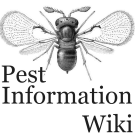Publications for:
pest = Tetranychus urticae
country = Netherlands
found 19 publications:2022
Artificial selection for timing of dispersal in predatory mites yields lines that differ in prey exploitation strategiesEcology and Evolution (2022) 12 (3 - e8760)
publishers website - pestinfo wiki
2020
Spider mites cause more damage to tomato in the dark when induced defenses are lowerJournal of Chemical Ecology (2020) 46 (7), 631-641
publishers website - pestinfo wiki
Transcriptional and metabolite analysis reveal a shift in direct and indirect defences in response to spider-mite infestation in cucumber (Cucumis sativus)
Plant Molecular Biology (2020) 103 (4-5), 489-505
publishers website - pestinfo wiki
2016
Metabolic adaptations in a range-expanding arthropodEcology and Evolution (2016) 6 (18), 6556-6564
publishers website - pestinfo wiki
2015
Altered volatile profile associated with precopulatory mate guarding attracts spider mite malesJournal of Chemical Ecology (2015) 41 (2), 187-193
publishers website - pestinfo wiki
2011
Ambulatory dispersal in Tetranychus urticae: an artificial selection experiment on propensity to disperse yields no responseExperimental and Applied Acarology (2011) 53 (4), 349-360
publishers website - pestinfo wiki
Mate choice promotes inbreeding avoidance in the two-spotted spider mite
Experimental and Applied Acarology (2011) 54 (2), 119-124
publishers website - pestinfo wiki
Acaricide resistance and resistance mechanisms in Tetranychus urticae populations from rose greenhouses in the Netherlands
Pest Management Science (2011) 67 (11), 1424-1433
publishers website - pestinfo wiki
2010
Genetic variation in jasmonic acid- and spider mite-induced plant volatile emission of cucumber accessions and attraction of the predator Phytoseiulus persimilisJournal of Chemical Ecology (2010) 36 (5), 500-512
publishers website - pestinfo wiki
2007
Microsatellite markers reveal spatial genetic structure of Tetranychus urticae (Acari: Tetranychidae) populations along a latitudinal gradient in EuropeExperimental and Applied Acarology (2007) 41 (4), 225-241
publishers website - pestinfo wiki
2003
Adaptive learning in arthropods: spider mites learn to distinguish food qualityExperimental and Applied Acarology (2003) 30 (4), 233-247
publishers website - pestinfo wiki
2001
Resistance to 2-tridecanone in Tetranychus urticae: effects of induced resistance, cross-resistance and heritabilityExperimental and Applied Acarology (2001) 25 (9), 717-730
publishers website - pestinfo wiki
2000
How predatory mites learn to cope with variability in volatile plant signals in the environment of their herbivorous preyExperimental and Applied Acarology (2000) 24 (12), 881-895
publishers website - pestinfo wiki
1999
Absence of odour-mediated avoidance of heterospecific competitors by the predatory mite Phytoseiulus persimilisEntomologia Experimentalis et Applicata (1999) 92 (1), 73-82
publishers website - pestinfo wiki
Biological control of insect pests by predators, parasitoids and entomopathogenic fungi in the Netherlands from a practical point of view
Phytoparasitica (1999) 27 (1), p. 75
pestinfo wiki
1998
Trade-off between diapause and other life-history traits in the spider mite Tetranychus urticaeEcological Entomology (1998) 23 (3), 298-304
publishers website - pestinfo wiki
1997
Toxicity of methyl ketones from tomato trichomes to Tetranychus urticae KochExperimental and Applied Acarology (1997) 21 (6-7), 473-484
publishers website - pestinfo wiki
1996
Behavioural response and winter survival of mated and unmated diapausing females of the Tetranychus atlanticus-urticae complex (Acari, Tetranychidae)Experimental and Applied Acarology (1996) 20 (3), 167-175
publishers website - pestinfo wiki
Susceptibility of populations of twospotted spider mites (Acari: Tetranychidae) from Florida, Holland, and the Canary Islands to abamectin and characterization of abamectin resistance
Journal of Economic Entomology (1996) 89 (3), 594-601
pestinfo wiki
